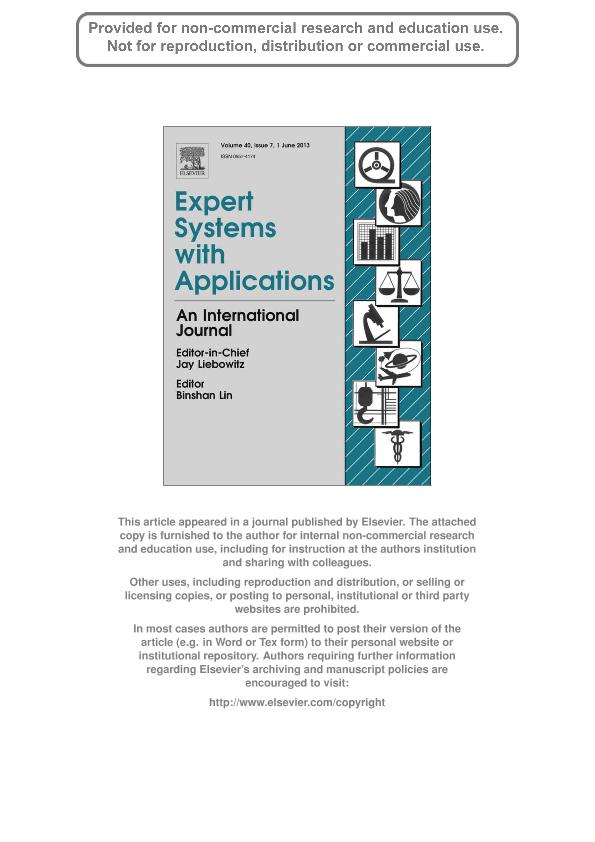Mostrar el registro sencillo del ítem
dc.contributor.author
Yannibelli, Virginia Daniela

dc.contributor.author
Amandi, Analia Adriana

dc.date.available
2018-01-16T19:09:38Z
dc.date.issued
2012-11
dc.identifier.citation
Amandi, Analia Adriana; Yannibelli, Virginia Daniela; Hybridizing a multi-objective simulated annealing algorithm with a multi-objective evolutionary algorithm to solve a multi-objective project scheduling problem; Elsevier; Expert Systems with Applications; 40; 7; 11-2012; 2421-2434
dc.identifier.issn
0957-4174
dc.identifier.uri
http://hdl.handle.net/11336/33479
dc.description.abstract
In this paper, a multi-objective project scheduling problem is addressed. This problem considers two conflicting, priority optimization objectives for project managers. One of these objectives is to minimize the project makespan. The other objective is to assign the most effective set of human resources to each project activity. To solve the problem, a multi-objective hybrid search and optimization algorithm is proposed. This algorithm is composed by a multi-objective simulated annealing algorithm and a multi-objective evolutionary algorithm. The multi-objective simulated annealing algorithm is integrated into the multi-objective evolutionary algorithm to improve the performance of the evolutionary-based search. To achieve this, the behavior of the multi-objective simulated annealing algorithm is self-adaptive to either an exploitation process or an exploration process depending on the state of the evolutionary-based search. The multi-objective hybrid algorithm generates a number of near non-dominated solutions so as to provide solutions with different trade-offs between the optimization objectives to project managers. The performance of the multi-objective hybrid algorithm is evaluated on nine different instance sets, and is compared with that of the only multi-objective algorithm previously proposed in the literature for solving the addressed problem. The performance comparison shows that the multi-objective hybrid algorithm significantly outperforms the previous multi-objective algorithm.
dc.format
application/pdf
dc.language.iso
eng
dc.publisher
Elsevier

dc.rights
info:eu-repo/semantics/openAccess
dc.rights.uri
https://creativecommons.org/licenses/by-nc-nd/2.5/ar/
dc.subject
Multi-Objective Project Scheduling
dc.subject
Multi-Objective Hybrid Algorithm
dc.subject
Multi-Objective Simulated Annealling Algorithm
dc.subject
Multi-Objective Evolutionary Algorithm
dc.subject.classification
Ciencias de la Computación

dc.subject.classification
Ciencias de la Computación e Información

dc.subject.classification
CIENCIAS NATURALES Y EXACTAS

dc.title
Hybridizing a multi-objective simulated annealing algorithm with a multi-objective evolutionary algorithm to solve a multi-objective project scheduling problem
dc.type
info:eu-repo/semantics/article
dc.type
info:ar-repo/semantics/artículo
dc.type
info:eu-repo/semantics/publishedVersion
dc.date.updated
2017-11-28T18:47:25Z
dc.journal.volume
40
dc.journal.number
7
dc.journal.pagination
2421-2434
dc.journal.pais
Países Bajos

dc.journal.ciudad
Amsterdam
dc.description.fil
Fil: Yannibelli, Virginia Daniela. Consejo Nacional de Investigaciones Científicas y Técnicas. Centro Científico Tecnológico Conicet - Tandil. Instituto Superior de Ingeniería del Software. Universidad Nacional del Centro de la Provincia de Buenos Aires. Instituto Superior de Ingeniería del Software; Argentina
dc.description.fil
Fil: Amandi, Analia Adriana. Consejo Nacional de Investigaciones Científicas y Técnicas. Centro Científico Tecnológico Conicet - Tandil. Instituto Superior de Ingeniería del Software. Universidad Nacional del Centro de la Provincia de Buenos Aires. Instituto Superior de Ingeniería del Software; Argentina
dc.journal.title
Expert Systems with Applications

dc.relation.alternativeid
info:eu-repo/semantics/altIdentifier/doi/http://dx.doi.org/10.1016/j.eswa.2012.10.058
dc.relation.alternativeid
info:eu-repo/semantics/altIdentifier/url/http://www.sciencedirect.com/science/article/pii/S0957417412011827
Archivos asociados
